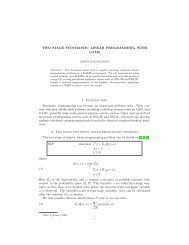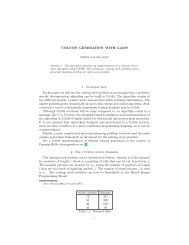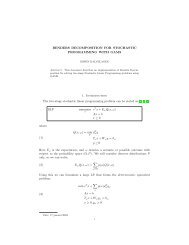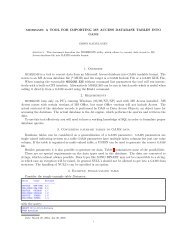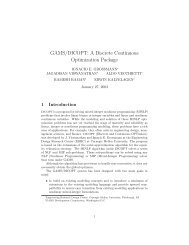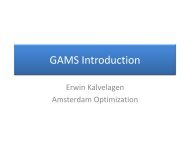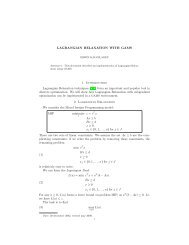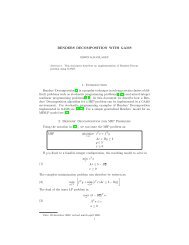Dantzig-Wolfe Decomposition with GAMS - Amsterdam Optimization ...
Dantzig-Wolfe Decomposition with GAMS - Amsterdam Optimization ...
Dantzig-Wolfe Decomposition with GAMS - Amsterdam Optimization ...
Create successful ePaper yourself
Turn your PDF publications into a flip-book with our unique Google optimized e-Paper software.
4 ERWIN KALVELAGENSub 1DualsSub 2MasterNew columns.Sub KFigure 1. Communication between restricted master and sub-problemsThe attractiveness of a variable λ k,j can be measured by its reduced cost 1 . Ifwe denote the dual variables for constraint B 0 x 0 + Bλ ′ = b 0 by π 1 and those forthe convexity constraints ∑ j δ k,jλ ′ k,j= 1 by π(k) 2 , then reduced cost for the masterproblem look like:((14) σ k,j = (c T k x (j)k) − Bk x (j) )πT k = (c T k − π1 T B k )x (j)kδ − π(k) 2 δ k,jk,jAssuming the sub-problem to be bounded, the most attractive bfs (basic feasiblesolution) x k to enter the master problem is found by maximizing the reduced costgiving the following LP:(15)min σ k = (c T k − π1 T B k )x k − π (k)x2kB k x x = b kx k ≥ 0The operation to find these reduced costs is often called Pricing. If σk ∗ < 0 we canintroduce the a new column λ k,j to the master, <strong>with</strong> a cost coefficient of c T k x∗ k .A basic <strong>Dantzig</strong>-<strong>Wolfe</strong> decomposition algorithm can now be formulated:<strong>Dantzig</strong>-<strong>Wolfe</strong> decomposition algorithm.{initialization}Choose initial subsets of variables.while true do1 The reduced cost of a variable xj is(13) σ j = c j − π T A jwhere A j is the column of A corresponding to variable x j , and π are the duals.



